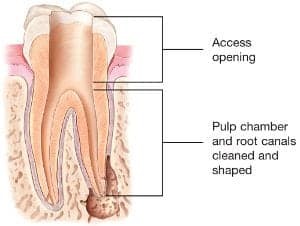“Endo” is the Greek word for “inside” and “odont” is Greek for “tooth.” Endodontic treatment treats the inside of the tooth. Root canal treatment is one type of endodontic treatment.
Inside the tooth, under the white enamel and a hard layer called the dentin, is a soft tissue called the pulp. The pulp contains blood vessels, nerves and connective tissue and creates the surrounding hard tissues of the tooth during development. The pulp extends from the crown of the tooth to the tip of the roots where it connects to the tissues surrounding the root. The pulp is important during a tooth’s growth and development. However, once a tooth is fully mature it can survive without the pulp, because the tooth continues to be nourished by the tissues surrounding it.
Endodontic treatment is necessary when the pulp, the soft tissue inside the root canal, becomes inflamed or infected. The inflammation or infection can have a variety of causes: deep decay repeated dental procedures on the tooth or a crack or chip in the tooth. In addition, an injury to a tooth may cause pulp damage even if the tooth has no visible chips or cracks. If pulp inflammation or infection is left untreated, it can cause pain or lead to an abscess.
Root canal treatment is designed to eliminate bacteria from the infected root canal, prevent reinfection of the tooth and save the natural tooth. When one undergoes a root canal, the inflamed or infected pulp is removed and the inside of the tooth is carefully cleaned and disinfected, then filled and sealed.
Endodontic treatment can often be performed in one or two visits and involves the following steps:

Many endodontic procedures are performed to relieve the pain of toothaches caused by pulp inflammation or infection. With modern techniques and anesthetics, most patients report that they experience no pain during the procedure. Nitrous oxide and oral sedation options are also available to patients who may feel anxious.
For the first few days after treatment, your tooth may feel sensitive, especially if there was pain or infection before the procedure. This discomfort can be relieved with over-the-counter or prescription medications. It is normal that your tooth may continue to feel slightly different from your other teeth for some time after your endodontic treatment is completed.
Most patients experience little to no discomfort after treatment. Every patient will also be provided with Dr. Chung’s direct cell phone number after treatment so that you can easily reach her at any time if needed.
According to a study published in the Journal of Endodontics, root canal therapy performed by an endodontist lasts, on average, a 5% higher 10-year survival rate. Overall, survival rates are:
And according to the American Academy of Endodontics, many root canal treatments last a lifetime.
I’d rather eat dirt than have another root canal. That said, if one were necessary, I would go IMMEDIATELY to Dr. Chung, she was overflowing with competence and confidence, and was cordial and personable. All the ladies in the office treated us as if we were family. I’d go back there in a minute!
Root canals are never any fun of course, but Dr. Chung was truly amazing. She was so attentive, painless, and careful. But what impressed me most is that she clearly worked intently enough to get me through the process as fast as possible without compromising quality. The staff there is pretty amazing too. So if you have to get endo work done, this is the place for it!
Great office, staff and talented Dentists. Took care me so well and fast. Even had a menu of goodies to make me feel better to pick from during my procedure and after. Dr. Chung and Tiffany her assistant were the best.
I wish there were ten stars to give! What an incredible place! Fantastic facility with high-tech imaging equipment. I came in with a tooth that had already had two root canals. Dr. Chung was able to assess the situation and was extremely knowledgeable and kind. The staff was incredible, kind and so helpful. When you're in pain, kindness is currency. And they have that in spades. Don't go anywhere else.
I cannot think that one could have a better dental experience…except for not having to go (LOL!) than the one I had at Five Cities Endo! Dr. Chung was simply amazing in every way and the team of assistants equally great! They took a normally stressful situation (needing a root canal) and not only made it virtually pain free (during and after) but were so focused on making me as comfortable as possible that I’m actually writing a positive thumbs up review for dental work. 😀 To say that I highly recommend them is an understatement. Thank you Dr. Chung and the whole Five Cities Endo team!!